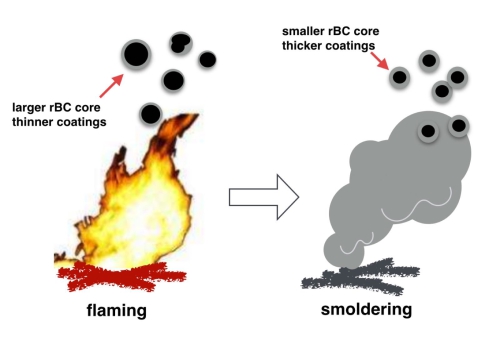Mixing State of Black Carbon from Biomass Burning Differs Evidently in Different Combustion Phase
Date:2017-12-20
As a short-lived climate forcer, black carbon aerosols in the atmosphere play a vital role in climate change by absorbing solar radiation and altering the formation, lifespan and albedo of clouds. It also provides "seed" for haze formation in urban/regional scale. In northern China, open biomass burning (OBB), such as straw burning after harvesting, is one of important sources of refractory black carbon (rBC). OBB emits both soot particles and substantial amount of semi-volatile organic matters, both of which will undergo a very complicated mixing and evolution processes in the atmosphere to change their ability to form cloud condensation nuclei.
At present, the mixing state of OBB aerosol is usually studied through field studies. Due to influences such as meteorological factors, diffusion and transmission, the mixing state of rBC normally changes significantly with the aging time. In order to better characterize the aging process of rBC, study on the freshly emitted rBC during the whole combustion process is urgently needed. Dr. PAN Xiaole from CAS Institute of Atmospheric Physics and his Japanese collaborators conducted combustion lab experiments to simulate and investigate the rBC emission and mixing state characteristics under different combustion conditions. It was found that the mode diameter of mass size distribution of rBC clearly decreased evidently as combustion state of biomass shifted from flaming-dominant to smoldering-dominant.
“This result indicated that the rBC coagulation/growth process was intensive during flaming combustion as a result of substantial production of rBC precursor particles.” says PAN.

Schematic diagram illustrating the mixing state of rBC during flaming combustion (left) and smoldering combustion (right). (Image by PAN Xiaole)
Furthermore, due to the strong emission of the semi-volatile organic matters and lower production rate of rBC particles during smoldering combustion, the coating thickness of rBC particles was 20 per cent larger than that from flaming combustion on average. This finding was instrumental to the comprehensive understanding of the evolution of the mixed state of black carbon aerosol and its forcing effect of climate radiation.
The research paper is published in Atmospheric Chemistry and Physics.
Citation: Pan, X., Kanaya, Y., Taketani, F., Miyakawa, T., Inomata, S., Komazaki, Y., Tanimoto, H., Wang, Z., Uno, I., and Wang, Z.: Emission characteristics of refractory black carbon aerosols from fresh biomass burning: a perspective from laboratory experiments, Atmos. Chem. Phys., 17, 13001-13016, https://doi.org/10.5194/acp-17-13001-2017 , 2017.
Media contact: Ms. LIN Zheng, jennylin@mail.iap.ac.cn
